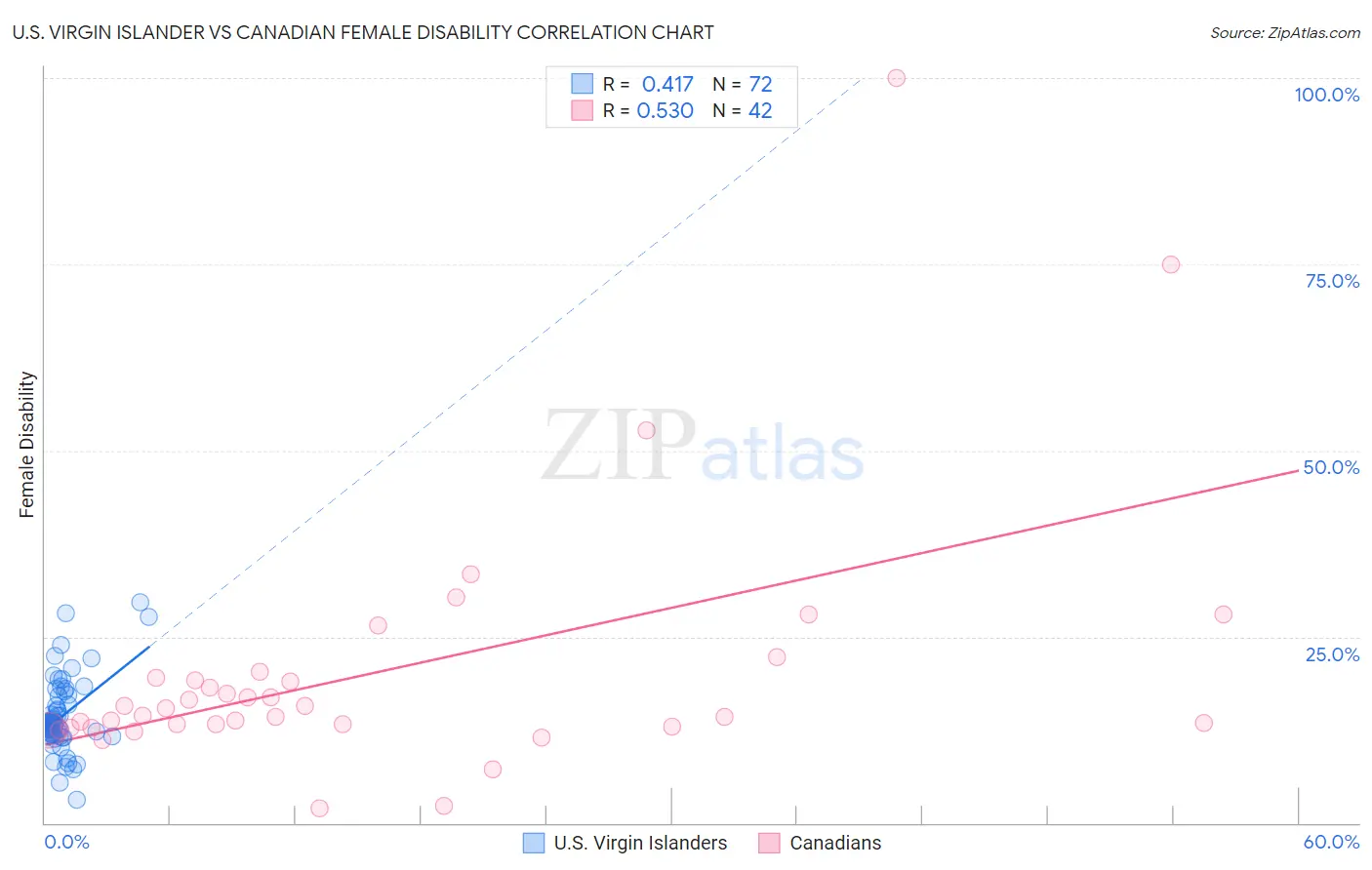U.S. Virgin Islander vs Canadian Female Disability
COMPARE
U.S. Virgin Islander
Canadian
Female Disability
Female Disability Comparison
U.S. Virgin Islanders
Canadians
13.1%
FEMALE DISABILITY
0.1/ 100
METRIC RATING
281st/ 347
METRIC RANK
12.6%
FEMALE DISABILITY
2.6/ 100
METRIC RATING
242nd/ 347
METRIC RANK
U.S. Virgin Islander vs Canadian Female Disability Correlation Chart
The statistical analysis conducted on geographies consisting of 87,518,599 people shows a moderate positive correlation between the proportion of U.S. Virgin Islanders and percentage of females with a disability in the United States with a correlation coefficient (R) of 0.417 and weighted average of 13.1%. Similarly, the statistical analysis conducted on geographies consisting of 437,475,870 people shows a substantial positive correlation between the proportion of Canadians and percentage of females with a disability in the United States with a correlation coefficient (R) of 0.530 and weighted average of 12.6%, a difference of 3.5%.

Female Disability Correlation Summary
| Measurement | U.S. Virgin Islander | Canadian |
| Minimum | 3.2% | 2.0% |
| Maximum | 29.7% | 100.0% |
| Range | 26.5% | 98.0% |
| Mean | 14.2% | 20.3% |
| Median | 13.3% | 14.9% |
| Interquartile 25% (IQ1) | 12.0% | 12.9% |
| Interquartile 75% (IQ3) | 15.7% | 19.4% |
| Interquartile Range (IQR) | 3.8% | 6.5% |
| Standard Deviation (Sample) | 4.8% | 17.6% |
| Standard Deviation (Population) | 4.8% | 17.4% |
Similar Demographics by Female Disability
Demographics Similar to U.S. Virgin Islanders by Female Disability
In terms of female disability, the demographic groups most similar to U.S. Virgin Islanders are Irish (13.1%, a difference of 0.030%), Welsh (13.1%, a difference of 0.080%), English (13.1%, a difference of 0.080%), Arapaho (13.0%, a difference of 0.12%), and Hmong (13.1%, a difference of 0.22%).
| Demographics | Rating | Rank | Female Disability |
| Portuguese | 0.1 /100 | #274 | Tragic 13.0% |
| Cheyenne | 0.1 /100 | #275 | Tragic 13.0% |
| Immigrants | Dominica | 0.1 /100 | #276 | Tragic 13.0% |
| Spanish | 0.1 /100 | #277 | Tragic 13.0% |
| Scottish | 0.1 /100 | #278 | Tragic 13.0% |
| Arapaho | 0.1 /100 | #279 | Tragic 13.0% |
| Irish | 0.1 /100 | #280 | Tragic 13.1% |
| U.S. Virgin Islanders | 0.1 /100 | #281 | Tragic 13.1% |
| Welsh | 0.0 /100 | #282 | Tragic 13.1% |
| English | 0.0 /100 | #283 | Tragic 13.1% |
| Hmong | 0.0 /100 | #284 | Tragic 13.1% |
| Bangladeshis | 0.0 /100 | #285 | Tragic 13.1% |
| Fijians | 0.0 /100 | #286 | Tragic 13.1% |
| Yaqui | 0.0 /100 | #287 | Tragic 13.2% |
| Whites/Caucasians | 0.0 /100 | #288 | Tragic 13.2% |
Demographics Similar to Canadians by Female Disability
In terms of female disability, the demographic groups most similar to Canadians are Immigrants from Senegal (12.6%, a difference of 0.010%), Alsatian (12.6%, a difference of 0.020%), Japanese (12.6%, a difference of 0.050%), Immigrants from Jamaica (12.6%, a difference of 0.16%), and Spanish American Indian (12.6%, a difference of 0.18%).
| Demographics | Rating | Rank | Female Disability |
| Malaysians | 5.0 /100 | #235 | Tragic 12.5% |
| Immigrants | West Indies | 4.4 /100 | #236 | Tragic 12.6% |
| Slavs | 3.8 /100 | #237 | Tragic 12.6% |
| Yugoslavians | 3.7 /100 | #238 | Tragic 12.6% |
| Barbadians | 3.6 /100 | #239 | Tragic 12.6% |
| German Russians | 3.2 /100 | #240 | Tragic 12.6% |
| Japanese | 2.7 /100 | #241 | Tragic 12.6% |
| Canadians | 2.6 /100 | #242 | Tragic 12.6% |
| Immigrants | Senegal | 2.5 /100 | #243 | Tragic 12.6% |
| Alsatians | 2.5 /100 | #244 | Tragic 12.6% |
| Immigrants | Jamaica | 2.2 /100 | #245 | Tragic 12.6% |
| Spanish American Indians | 2.1 /100 | #246 | Tragic 12.6% |
| Menominee | 2.1 /100 | #247 | Tragic 12.6% |
| Carpatho Rusyns | 2.0 /100 | #248 | Tragic 12.6% |
| Immigrants | Congo | 1.8 /100 | #249 | Tragic 12.7% |